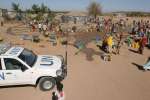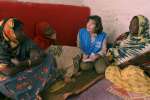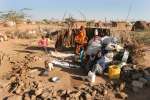UNHCR starts moving Somali refugees to a new camp in Ethiopia
News Stories, 3 April 2009

ADDIS ABABA, Ethiopia, April 3 (UNHCR) – The UN refugee agency on Friday began the relocation of thousands of Somali refugees from a transit centre in Dolo Ado, south-east Ethiopia to the newly opened Bokolmanyo camp, further inland from the border with Somalia.
A first convoy of 10 buses left Dolo Ado this morning carrying 157 Somali refugees, who fled the renewed fighting in central and southern Somalia over the past few months. They are part of a group of 5,000 Somalis who have recently been recognized as refugees by the Ethiopian government with the expert support of UNHCR. They will all be moved to Bokolmanyo
In addition, some 5,000 Somalis are staying with the local community in Dolo Ado and waiting to be screened. They claim to have fled the fighting and general insecurity in Somalia, most of them leaving the country after the withdrawal of Ethiopian troops last December and January.
In February, UNHCR reported the presence of an estimated 10,000 Somali asylum seekers in Dolo Ado, most of whom have been enjoying the hospitality of Ethiopians who are ethnic Somalis. The opening of the new camp and subsequent extension of international protection and assistance might encourage thousands of others living with the community to apply for asylum.
The land at Bokolmanyo, located north-west of Dolo Ado, has been provided by the local authorities. The new camp can accommodate up to 20,000 refugees and UNHCR and its partners are intensifying the work of expanding basic infrastructure, including water and sanitation services, a health centre, relevant basic communal facilities and a children's centre. Establishment of schools and other facilities and services is also planned.
After arriving at Bokolmanyo, the refugees will spend about three days in a reception area where they will be allocated plots of land and given building materials to construct their huts. Refugees will also be provided with food as well as tarpaulins, blankets, kitchen sets, jerry cans, family tents and mosquito nets.
The Somali region of Ethiopia already hosts more than 33,000 Somali refugees in three camps – Kebribeyah, Shedder and Aw Barre. With the new arrivals, the total is expected to pass the 40,000 mark very soon.
At the peak of the Somali refugee crisis in the early 1990s, the region hosted 628,000 refugees in eight camps. The overwhelming majority of those refugees returned to their homes between 1997 and 2005. However, by mid-2005, UNHCR had closed all camps but the Kebribeyah site. Unfortunately, due to renewed conflicts and general violence in southern and central parts of Somalia, two new camps had to be opened in Ethiopia in 2007 and 2008 to accommodate new refugees fleeing Somalia.
By Kisut Gebre Egziabher in Addis Ababa, Ethiopia



















































